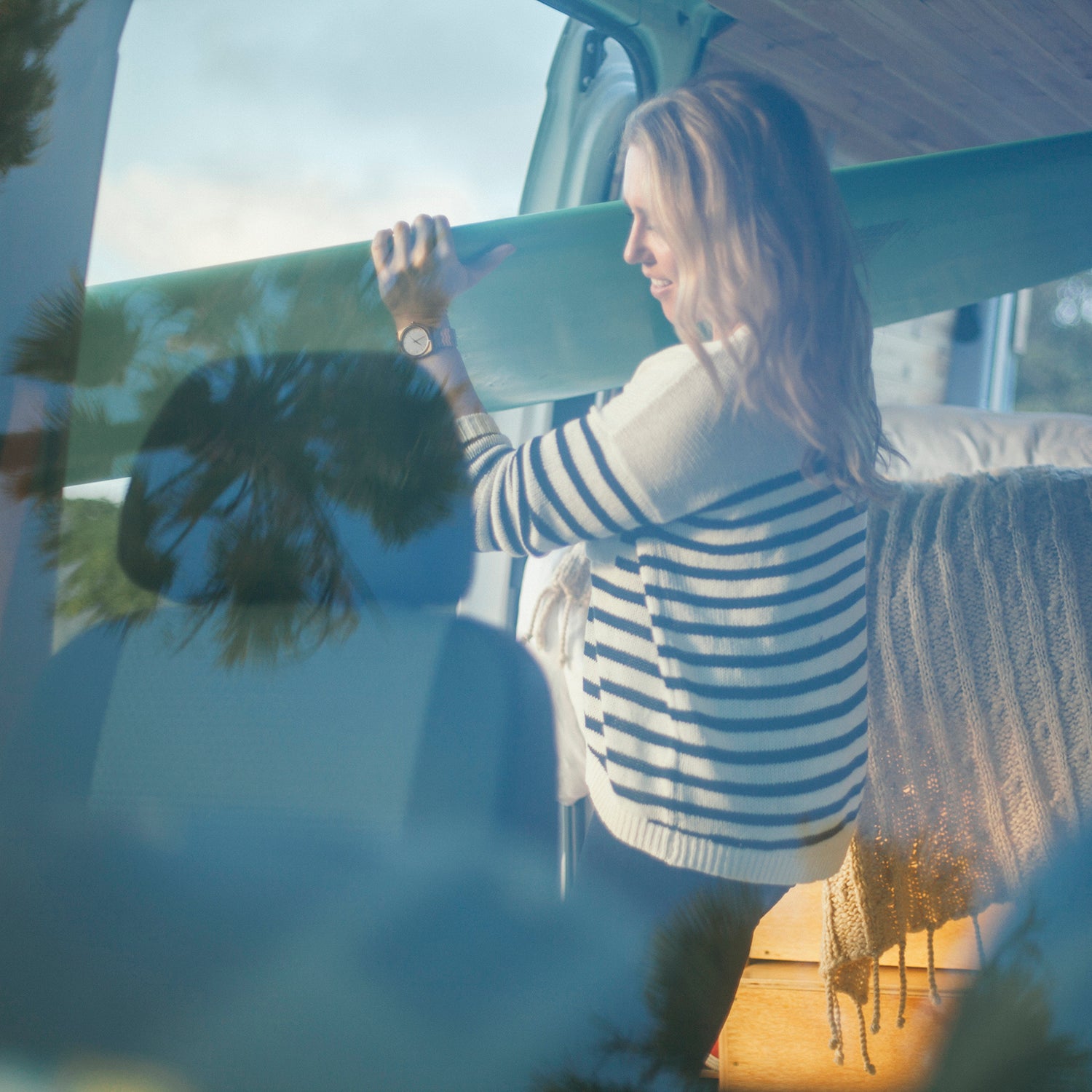The first time I thought the #vanlife dream might be a farce I was sitting on the floor of the van after my fiancé slammed the door and stormed off, proclaiming that he needed space to clear his head. Needing to distract myself, I found a picture we’d recently taken at Grand Teton National Park, upped the saturation and contrast a little, and published it to with a superlative-laden caption and the hashtag #vanlife.
I felt momentary relief as I watched the Instagram likes climb. I felt guilt immediately.
Earlier that year, we’d bought into the romantic Instagram version of #vanlife. After spending our twenties working full-time, my fiancé and I had reached a point where we were overcome by the desire to escape the grind and fill our days doing the things we love—surfing, skiing, hiking, biking, and exploring. So we saved up, sold most of our things, bought a 2009 Dodge Sprinter, spent two months turning it into a tiny cabin on wheels, left our 9-to-5 jobs, and hit the road with a plan to drive around the country for a year.
Five months into living the dream, I can attest that it is, without a doubt, one of the best decisions I’ve ever made. We’ve seen places we’ve always dreamed of going, camped in some of the most spectacular destinations on the planet, and experienced the magic of nature we previously only briefly tapped into.
I’ve inadvertently succumbed to the notion that living in a van should be pretty. Maybe it’s simply because our followers like those perfectly-lit photos of our perfectly cozy van—and “likes” feel good.
But I’ve also discovered that, despite how it appears on Instagram, #vanlife is still real life—with all its ups and downs and stupid arguments. Though you wouldn’t know it judging by our feed.
As of this writing, there were 335,919 photos on Instagram tagged #vanlife and thousands more denoting more specifically things like #sprintervanlife, #vanagonlife, and #westylife. (Cheers to #vanlife founder for giving the movement a name that united a community.) The photos feature hand-sanded countertops and moonlit hikes, mountaintop sun salutations and sepia-toned bonfires. It’s the salve for our concurrent desires to do more and do so much less. It feeds our need to escape, our aversion to the status quo and the system. It’s the answer to our all too common gripe that we don’t have enough hours in the day to do the things that make us happiest.
My parents and their friends are quick to remind me that #vanlife is nothing new. My dad’s surf voyages to Mexico in the ‘60s have been recounted to me since I was too young to understand the kind of “tripping” that was actually transpiring on those adventures. But what was once a lifestyle strictly reserved for the dirtbag wanderer is today attractive even to those who value a career and a steady paycheck. Remote jobs, nationwide WiFi, and the influx of web-based work have all made this lifestyle more attainable than ever.
An Inside Look at #Vanlife
Watch for a tour of Irons and Stifter's Sprinter
Add to that the popularization of new high-top vans, like the , and it’s no wonder that #vanlife has extended beyond the VW-loving (and mechanically inclined) masses. Mercedes says it’s seen van sales nearly triple since 2010. Today, it’s nearly impossible to find a Sprinter on Craigslist in any outdoorsy town. , a website that provides tips and guides for converting Sprinter vans into campers, has seen a steady climb in traffic since launch, with about 1,000 unique visitors per day.
Our connectivity on blogs and social media has grown the movement, creating a wonderful community of like-minded strangers, excited to share their knowledge or meet up along the way. But for many, it’s also shifted the nature of the adventure. Once a soul-searching diversion from the rat race, van-living has now been co-opted by marketers into a new race entirely—one fueled by perfectly curated photos of conspicuously placed products.
For brands, it’s the ideal partnership: pay vanlife influencers to post beautiful photos of product, and, in turn, the influencers get to keep doing rad stuff. For those on the road, it’s an enticing alternative to real work. But, in the process, it’s also changed the landscape. As vanlifers race to build Instagram followings (and thus increase appeal to brands who pay), we’ve created an online version of #vanlife that’s a beautiful, hyperbolic version of reality. Goodbye messy counters and ragged bedspreads. Hello potted succulents and Mexican blankets.
While personally I’ve resisted the urge to exchange shout-outs for cash, I’ve inadvertently succumbed to the notion that living in a van should be pretty. Maybe it’s simply because our followers like those perfectly-lit photos of our perfectly cozy van—and “likes” feel good. Maybe it’s because the hard moments don’t translate well to Instagram, or because there’s this uncomfortable shame in admitting that it’s sometimes hard. When times are tough (see: sleepless nights in “nice” neighborhoods when I’m convinced I hear murderers trying to break in), we scroll through other vanlifers’ seemingly carefree existences and wonder if we’re doing it wrong. So we don’t show that stuff. And in doing so, we continue to perpetuate the illusion that #vanlife is perfect.
Which, come to think of it, maybe isn’t such a bad thing. I mean, it got us out here. And if the “perfect” life we share on Instagram is only part of our reality, I don’t think we have any right to complain.


